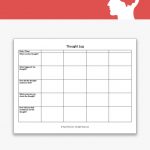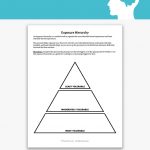Cognitive Distortions: Labeling Worksheet
Worksheet updated on May 23rd, 2025

Cognitive distortions are errors in thinking that can cause a person to misinterpret situations and see themselves in a negative light. They are powerful and can affect a person’s self-esteem, mood, and reactions to challenging situations. Teaching a client in therapy about how cognitive distortions may be impacting their mental health can be a great way to introduce helpful skills to challenge hurtful or negative thoughts and develop a healthier perspective.
Cognitive distortions can affect motivation, perspective, expectations, and self-image. They are powerful and can cause people to make negative and unfair assumptions about themselves and others. It is important to keep the impact of cognitive distortions in mind when using thought-challenging skills and other techniques from cognitive behavioral therapy.
A cognitive distortion that can be particularly powerful is labeling. Labeling can affect a client in many different ways. If a client tends to label, they need to understand how it is affecting them. This can help them understand how their thinking patterns may impair their mental health.
About This Worksheet
Labeling occurs when a person assigns a label that is hurtful, reductive, or negative in reaction to a single issue, upsetting event, or challenging situation. From learning how labeling affects clients in therapy, they start to understand how it can hurt their self-image and distort their interpretation of upsetting situations.
The Cognitive Distortions: Labeling worksheet breaks down the concept of labeling and how it affects a person, and provides reflection questions that encourage them to challenge the cognitive distortion. This worksheet is great for adults in individual or group sessions. It can help people who are struggling with mood disorders, anxiety, self-esteem issues, and challenges with stress management.
Instructions
This worksheet provides a brief explanation of what labeling is and an example of how it can affect a client’s thoughts. Review the material on the worksheet with your client. Then, instruct them to reflect on how labeling affects their life by answering the questions provided on the worksheet.
When the client has completed the reflection questions, review their responses with them, discuss how they are affected by labeling, and explore ways that thought-challenging can help. Provide a copy for the client to use as a reference.
References
Beck, J. S. (2020). Cognitive Behavior Therapy, Third Edition: Basics and Beyond. New York, NY, USA: Guilford Press.
Friedman, H. H. (2023). Overcoming cognitive distortions: How to recognize and challenge the thinking traps that make you miserable. ResearchGate.







